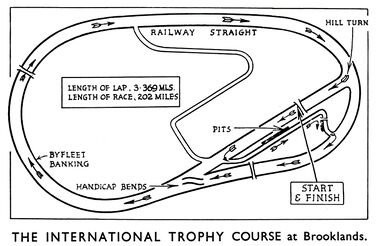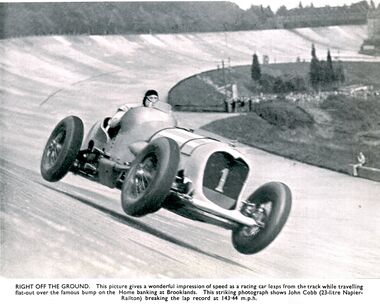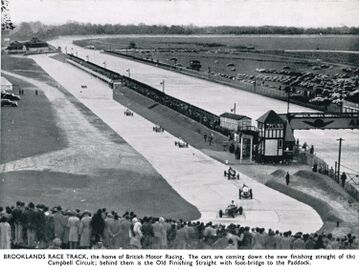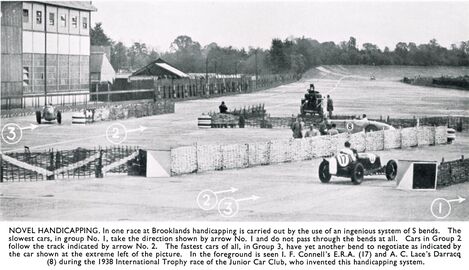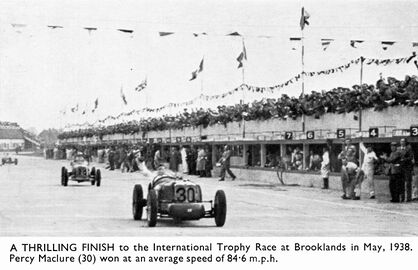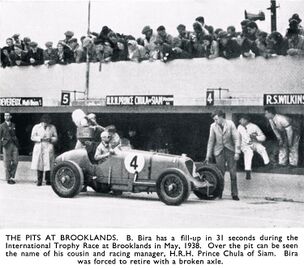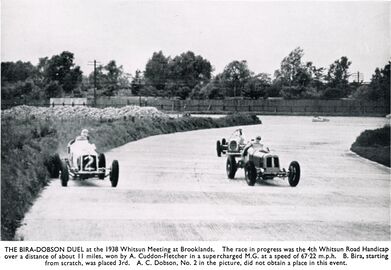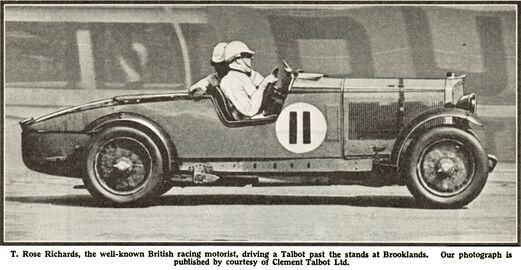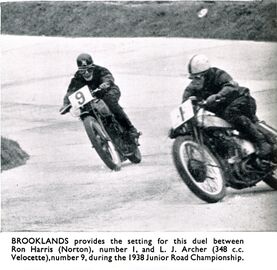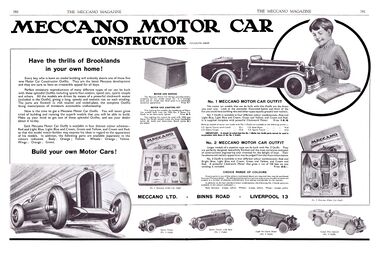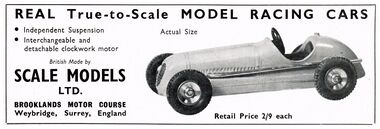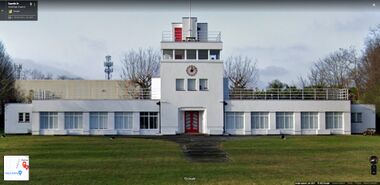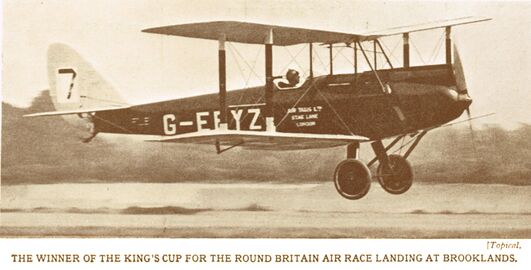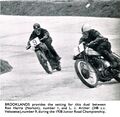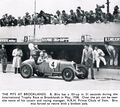Category:Brooklands
The curved outline of the original Brooklands racetrack is still visible in satellite views and maps. Part of the track circuit still exists. The pointer marks the location of the Control Tower.
The Brooklands complex was designed in the early C20th as an advanced technology centre for the growing subjects of motor cars and aircraft. The site consisted of a world-class banked racetrack surrounding a central aerodrome and airstrip, and became a centre of engineering.
The success of the aerodrome in attracting aircraft manufacturers Like Vickers ended up destroying the racetrack, as part of the track had to be cut away to allow Vickers' larger aircraft to get to the airstrip.
Brooklands Race Circuit
1938: The Brooklands International Trophy Course layout [image info]
John Cobb (23-litre Napier-Railton) briefly airborne after the "Brooklands Bump", while breaking the lap record at 143.44 m.p.h. Redrawn versions of this iconic image were used in the promotional advertising for both Meccano Ltd.'s 1930s Motor Car Constructor sets, and the Märklin equivalent [image info]
1933: "Have the thrills of Brooklands in your own home!", Meccano Motor Car Constructor [image info]
1939: Scale Models Ltd., a small model racing-car maker originally based at Brooklands [image info]
Brooklands is roughly egg-shaped. On the centre line one lap of the outer circuit measures 2 miles 1,350 yards, but as the concrete is 100 feet wide the lap distance is cut down by 87 yards if a car is kept within 10 feet of the inner edge. In its original form the small end of the egg was by-passed, as it were, so that at the end of a race cars shot down the by-pass (instead of swinging in an anticlockwise direction on to the Home Banking) and thereby provided the spectacle of the finish itself under conditions which enabled the public to see it at close quarters.
As speeds went up, however, the Finishing Straight became too short. One car did, in fact, go straight up the banking at the far end and over the top, so although the straight remains and still retains the title the "Old Finishing Straight," outer circuit races now terminate halfway down the Railway Straight, which is the fastest part of the course, along one side of the egg, as it were.
The outer circuit is steeply banked on the curves. The Home Banking, so-called because of its proximity to the enclosures, the club buildings and so on, rises to a height of 28 feet 8 ins. and is struck on a curve, the radius of which is 1,000 feet The other curve is known as the Byfleet; it has a radius of 1,500 feet.
Rising from the Old Finishing Straight is the Test Hill with its maximum gradient of 1 in 4. In years gone by its use was more obvious than it is now when even such a severe gradient does not try the average touring car. It also formed the means for competitive tests of speed, but only on rare occasions nowadays does one hear of an attempt on the Test Hill record. One of the reasons, perhaps, is that as machines become faster the distance they travel through the air when they shoot over the top of the hill becomes longer and the danger of accident greater.
The present record holder is R. G. J. Nash, who, on November 24, 1932, in a Frazer-Nash covered the 352 feet of the gradient at an average speed of 32.44 m.p.h.
Talking of speeds, I am often asked the safe maximum of the outer circuit at Brooklands. Well, I have already told you that John Cobb holds the record with a lap at over 143 miles an hour, from which it may be quite safely conjectured that speeds not far short of 150 m.p.h. are possible round the bankings. Cobb also has the honour of having reached the highest speed ever attained at Brooklands by covering one kilometre in the Napier-Railton at 151.97 m.p.h. — a phenomenal rate of progress.
The Brooklands Automobile Racing Club (B.A.R.C.) is the resident club at Brooklands, and is responsible for the popular Bank Holiday meetings. Dates are also set aside, however, for special races such as the International Trophy of the Junior Car Club and the 500-Kilometres Race of the British Racing Drivers' Club — the fastest long-distance race in the world, which began life as the 500-Miles Race and is again being modified for 1938.
Still further to add to the attractions of Brooklands, there is the Campbell Road Circuit, which was opened officially by Dame Ethel Locke King on April 20, 1937. Strictly speaking, it is not a road circuit because quite a large slice of the main outer circuit is included, but for the rest it provides road conditions and, by varying the nature of the racing programme, has added considerably to the attractiveness of the meetings. The first race on the new circuit took place on May 1, 1937. It resulted in a win for B. Bira (Prince Birabongse of Siam) who, in his Maserati, averaged 69.06 m.p.h.
— , F.J. Findon, , British Motor Sport: On Road and Track with the Modern Car, , Power and Speed, , 1938
Brooklands Aerodrome
2021: Google StreetView image of the Control Tower and Aero Clubhouse building, copyright Google 2021-2023 [image info]
Modelled architecture
The classic Art Deco Brooklands Control Tower and flanking Aero Clubroom still exists, and is now office space (on Sopwith Drive).
The building was modelled commercially as part of the Skybirds range, as the Skybirds Control Tower (Skybirds No.28) and the Skybirds Brooklands Club Building (Skybirds No.29). A faithful impression of the Brooklands building needed one of the control towers and two of the clubhouse pieces.
External links
Subcategories
This category has the following 3 subcategories, out of 3 total.
Pages in category ‘Brooklands’
The following 2 pages are in this category, out of 2 total.
Media in category ‘Brooklands’
The following 16 files are in this category, out of 16 total.
- 1938 Whitsun Meeting, Brooklands (PowerSpeed 1938).jpg 3,000 × 2,072; 915 KB
- Brooklands Race Track (PowerSpeed 1938).jpg 3,000 × 2,260; 1.19 MB
- DH-60G Gypsy Moth G-EBYZ, Brooklands (WBoA 6ed 1928).jpg 3,000 × 1,526; 755 KB
- Handicapping at Brooklands, 1938 (PowerSpeed 1938).jpg 3,000 × 1,728; 982 KB
- International Trophy Course, Brooklands (PowerSpeed 1938).jpg 3,000 × 1,943; 475 KB
- John Cobb airborne, Brooklands (PowerSpeed 1938).jpg 3,000 × 2,414; 1.31 MB
- London Bus Museum (LBM 2022).jpg 1,438 × 3,000; 1.09 MB
- London Bus Museum, A Living Heritage, front (LMB unk).jpg 3,000 × 2,126; 643 KB
- London Bus Museum, A Living Heritage, rear (LMB unk).jpg 3,000 × 2,129; 962 KB
- Meccano Motor Car Constructor, double-page spread (MM 1933-10).jpg 3,000 × 1,994; 1.15 MB
- On the Buses, London Bus Museum (LBM 2019-06-23).jpg 2,110 × 3,000; 1.04 MB
- Ron Harris and L J Archer, 1938 Junior Road Championship, Brooklands (PowerSpeed 1938).jpg 3,000 × 2,926; 1.42 MB
- T Rose Richards, driving a Talbot at Brooklands (MM 1934-07).jpg 3,000 × 1,556; 1.13 MB
- The Pits at Brooklands, May 1938 (PowerSpeed 1938).jpg 3,000 × 2,666; 1.37 MB
